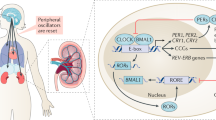Abstract
Stimulation of hepatic DNA synthesis can be achieved in the intact rat by α-hexachlorocyclohexane (α-HCH = α-benzene hexachloride). The extent of stimulation is high in the morning and low in the evening. These rhythmic variations in the rate of DNA synthesis are synchronized indirectly by the lightdark rhythm, but directly by the animal's feeding habits: Rats eat preferentially during the night. If the diurnal rhythm of food intake is abolished, the rhythmic fluctuations in the rate of DNA synthesis are no longer detectable; if rats are adapted to daily feeding periods of only 5 h, these fluctuations are pronounced and almost synchronized. Further experiments show that the time of feeding determines the time of DNA replication. It is concluded that food intake provides a „2nd stimulus” or permissive factor, which is required for the induction of DNA synthesis in a certain critical stage of the prereplicative phase. Labelling experiments with orotic acid suggest that food intake initially induces an increase of RNA synthesis.
The results indicate that controlled feeding schedules provide the possibility to synchronize, in the living animal, a proliferating population of hepatocytes. A hypothesis is derived which offers an explanation for the generation of the diurnal rhythm of cell proliferation in the liver.
Zusammenfassung
α-Hexachlorcyclohexan (α-HCH) stimuliert die DNS-Synthese in der Leber der Ratte. Das Ausmaß der Stimulierung ist hoch am Morgen und niedrig am Abend. Der wesentliche Zeitgeber für diese rhythmischen Variationen in der DNS-Synthese-Rate ist indirekt der Heil-Dunkel-Rhythmus, aber direkt die Freßgewohnheit der Ratten, die hauptsächlich nachts fressen. Wenn die Variationen in der Nahrungsaufnahme eliminiert werden, sind die rhythmischen Schwankungen der DNS-Synthese nicht mehr meßbar; wenn die Tiere täglich nur 5 Std gefüttert werden, treten sie verstärkt und weitgehend synchron auf. Weitere Experimente lassen erkennen, daß der Zeitpunkt der DNS-Replikation vom Zeitpunkt der Futteraufnahme bestimmt wird, die als „2. Stimulus” oder „permissive factor” in einem bestimmten Stadium der präreplikativen Phase fungiert. Markierungsversuche mit Orotsäure sprechen dafür, daß die Futterzufuhr zunächst einen Anstieg der RNS-Synthese-Rate auslöst.
Die Ergebnisse zeigen, daß die Anwendung des beschriebenen Fütterungs-Schemas die Synchronisation proliferierender Hepatozyten im lebenden Tier ermöglicht; es wird eine Hypothese formuliert, die die Entstehung der rhythmischen Schwankungen in der Zellproliferationsrate in der Leber erklären kann.
Similar content being viewed by others
Literatur
Barbiroli, B., Moruzzi, M. S., Monti, M. G., Tadolini, B.: Diurnal rhythmicity of mammalian DNA-dependent RNA polymerase activities I and II: Dependence on food intake. Biochem. biophys. Res. Commun. 54, 62–68 (1973)
Barbiroli, B., van Potter, R.: DNA synthesis and interaction between controlled feeding schedules and partial hepatectomy in rats. Science 172, 738–741 (1971)
Barnum, C. P., Jardetzky, C. D., Halberg, F.: Time relations among metabolic and morphologic 24 hour changes in mouse liver. Amer. J. Physiol. 195, 301–310 (1958)
Echave Llanos, J. M., Aloisso, M. D., Souto, M., Balduzzi, R., Surur, J. M.: Circadian variations of DNA synthesis, mitotic activity, and cell size of hepatocyte population in young immature male mouse growing liver. Virchows Arch. Abt. B 8, 309 (1971)
Halberg, F., Barnum, C. P., Silber, R. H., Bittner, J. J.: 24-hour rhythms at several levels of integration in mice on different lighting regimens. Proc. Soc. exp. Biol. (N.Y.) 97, 897–900 (1958)
Hayashi, S., Aramaki, Y., Noguchi, T.: Diurnal change in ornithine decarboxylase activity of rat liver. Biochem. biophys. Res. Commun. 46, 795–800 (1972)
Scheving, L. E., Pauly, J. E., v. Mayersbach, H., Dunn, J. D.: The effect of continuous light or darkness on the rhythm of the mitotic index in the corneal epithelium of the rat. Acta anat. (Basel) 88, 411–423 (1974)
Schlicht, I., Koransky, W., Magour, S., Schulte-Hermann, R.: Größe und DNS-Synthese der Leber unter dem Einfluß körperfremder Stoffe. Naunyn-Schmiedebergs Arch. Pharmak. exp. Path. 261, 26–41 (1968)
Schmidt, G., Thannhauser, S. J.: A method for the determination of desoxyribonucleic acid, ribonucleic acid, and phosphoproteins in animal tissues. J. biol. Chem. 161, 83–89 (1945)
Schulte-Hermann, R.: Induction of liver growth by xenobiotic compounds and other stimuli. Crit. Rev. in Toxicol. 3, 97–158 (1974)
Schulte-Hermann, R., Landgraf, H.: Circadiane rhythm of cell proliferation in rat liver: Synchronization by feeding habits. Z. Naturforsch. 29c, 421–424 (1974)
Schulte-Hermann, R.: Two-stage control of cell proliferation induced in rat liver by α-hexachlorocyclohexane. Cancer Res. (in press) (1977)
Schulte-Hermann, R., Leberl, C., Ruberg, I.: Stimulation of cell proliferation in rat liver by α-hexachlorocyclohexane or partial hepatectomy and end points during G1 of the inhibitory action of β-diethylaminoethylphenyldiallyl acetate. HCl (CFT 1201), β-diethylaminoethyldiphenylpropyl acetate. HCl (SKF 525-A) and actinomycin D. Biochim. Biophys. Acta (in press) (1976)
Schulte-Hermann, R., Thorn, R., Schlicht, I., Koransky, W.: Zahl und Ploidiegrad der Zellkerne der Leber unter dem Einfluß körperfremder Stoffe. Naunyn-Schmiedebergs Arch. Pharmak. exp. Path. 261, 42–58 (1968)
Wilson, J. W.: Diurnal rhythm of mitotic activity in the liver of the mouse. Anat. Rec. 101, 672 (1948)
Author information
Authors and Affiliations
Rights and permissions
About this article
Cite this article
Schulte-Hermann, R. Fütterungs-Rhythmen und die circadianen Variationen der Zellproliferation bei pharmakologisch induziertem Leberwachstum. Arch. Toxicol. 36, 235–245 (1976). https://doi.org/10.1007/BF00340531
Issue Date:
DOI: https://doi.org/10.1007/BF00340531




